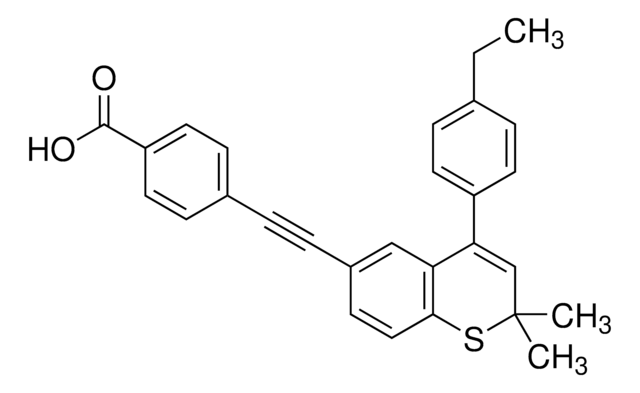B6688
BMS 493
≥98% (HPLC), powder, pan-RAR inverse agonist
Synonim(y):
(E)-4-[2-[5,6-Dihydro-5,5-dimethyl-8-(2-phenylethynyl)naphthalen-2-yl]ethen-1-yl]benzoic acid, 4-[(1E)-2-[5,6-Dihydro-5,5-dimethyl-8-(phenylethynyl)-2-naphthalenyl]ethenyl]-benzoic acid, BMS204, 493
About This Item
Polecane produkty
product name
BMS 493, ≥98% (HPLC)
Próba
≥98% (HPLC)
Postać
powder
kolor
light yellow to yellow
rozpuszczalność
DMSO: ≥20 mg/mL
inicjator
Bristol-Myers Squibb
temp. przechowywania
2-8°C
ciąg SMILES
CC1(C)CC=C(C#Cc2ccccc2)c3cc(\C=C\c4ccc(cc4)C(O)=O)ccc13
InChI
1S/C29H24O2/c1-29(2)19-18-24(14-10-21-6-4-3-5-7-21)26-20-23(13-17-27(26)29)9-8-22-11-15-25(16-12-22)28(30)31/h3-9,11-13,15-18,20H,19H2,1-2H3,(H,30,31)/b9-8+
Klucz InChI
YCADIXLLWMXYKW-CMDGGOBGSA-N
Opis ogólny
Zastosowanie
- as an inhibitor for the dietary and pharmacologic manipulation of retinoic acid (RA) activity in vivo and in vitro
- for human induced pluripotent stem cells (iPSCs) culture and ventricular cardiomyocytes (VCMs) differentiation
- to inhibit retinoic acid (RA) signaling in explants
- as a retinoic acid receptor (RAR) inhibitor for the induction of synaptonemal complex protein 3 (SCP3) and ATP-dependent RNA helicase (DDX4) in primordial germ cells (PGCs)
Działania biochem./fizjol.
Cechy i korzyści
Kod klasy składowania
11 - Combustible Solids
Klasa zagrożenia wodnego (WGK)
WGK 2
Temperatura zapłonu (°F)
Not applicable
Temperatura zapłonu (°C)
Not applicable
Certyfikaty analizy (CoA)
Poszukaj Certyfikaty analizy (CoA), wpisując numer partii/serii produktów. Numery serii i partii można znaleźć na etykiecie produktu po słowach „seria” lub „partia”.
Masz już ten produkt?
Dokumenty związane z niedawno zakupionymi produktami zostały zamieszczone w Bibliotece dokumentów.
Klienci oglądali również te produkty
Produkty
We offer many products related to non-steroid nuclear receptors for your research needs.
Cell cycle phases (G1, S, G2, M) regulate cell growth, DNA replication, and division in proliferating cells.
Apoptosis regulation involves multiple pathways and molecules for cellular homeostasis.
Nasz zespół naukowców ma doświadczenie we wszystkich obszarach badań, w tym w naukach przyrodniczych, materiałoznawstwie, syntezie chemicznej, chromatografii, analityce i wielu innych dziedzinach.
Skontaktuj się z zespołem ds. pomocy technicznej








